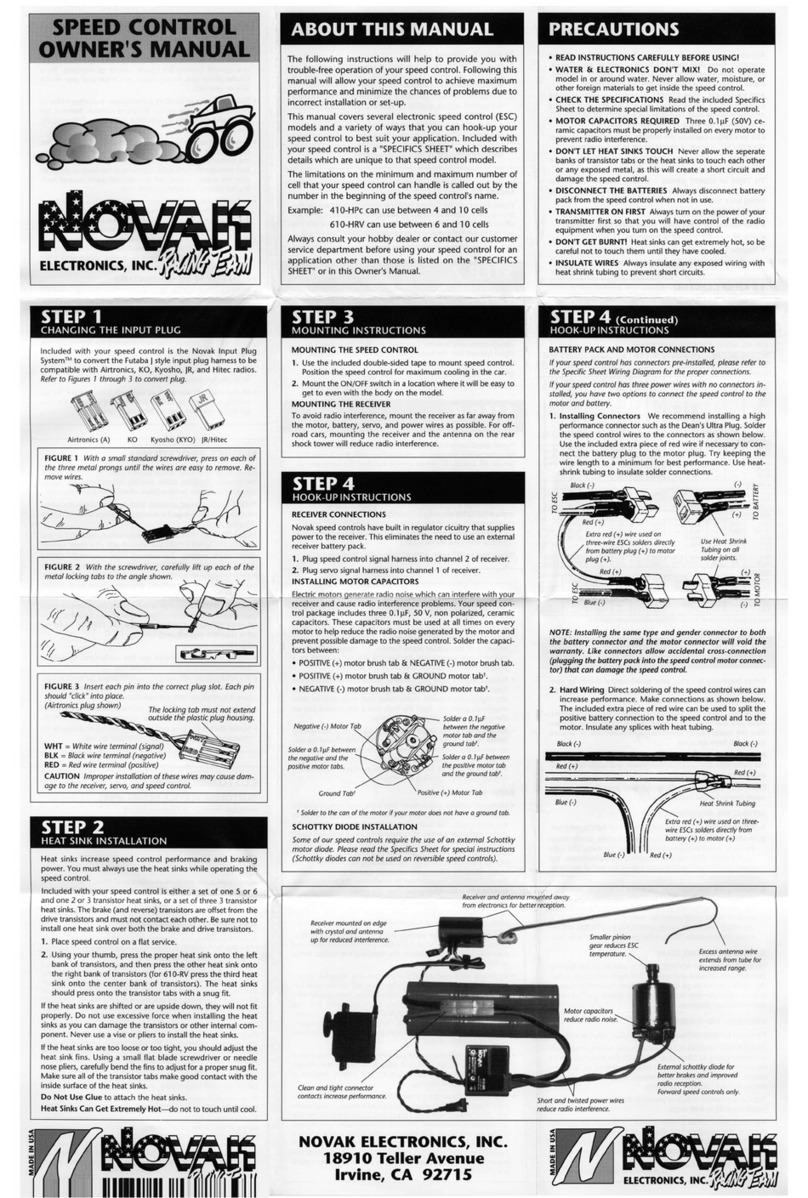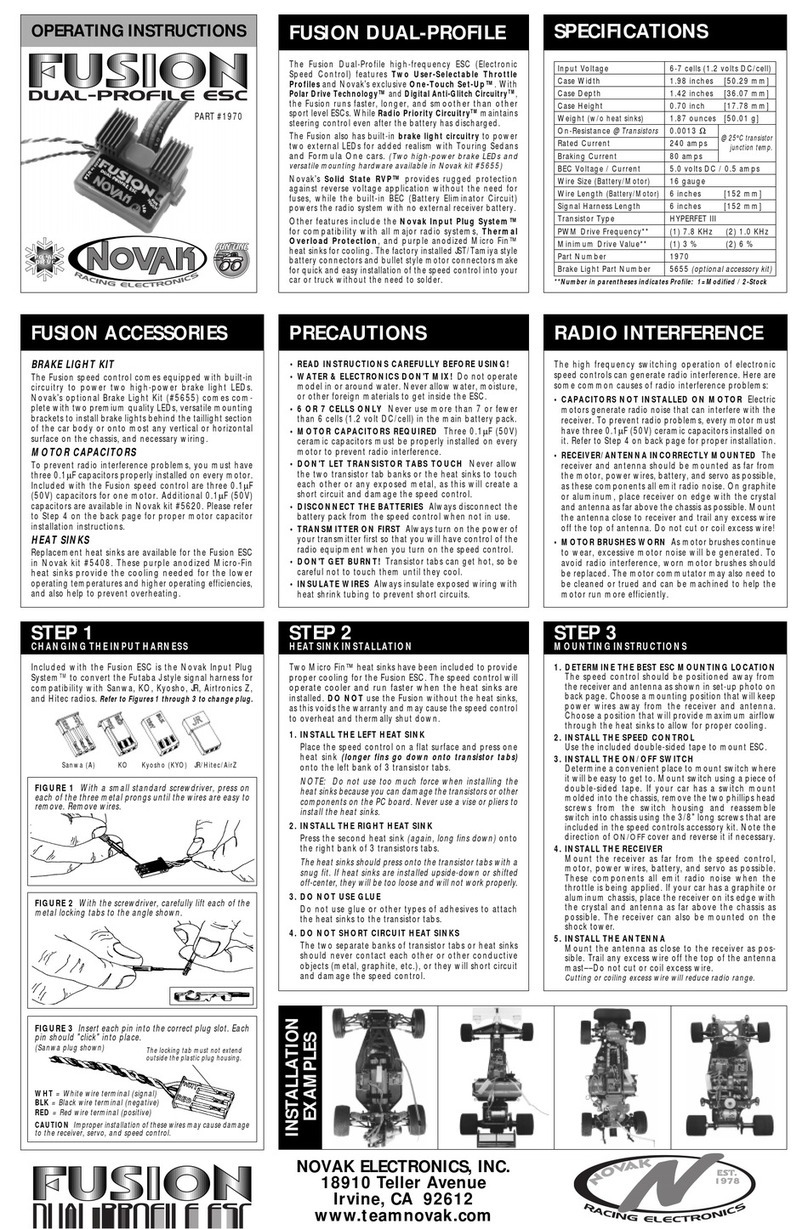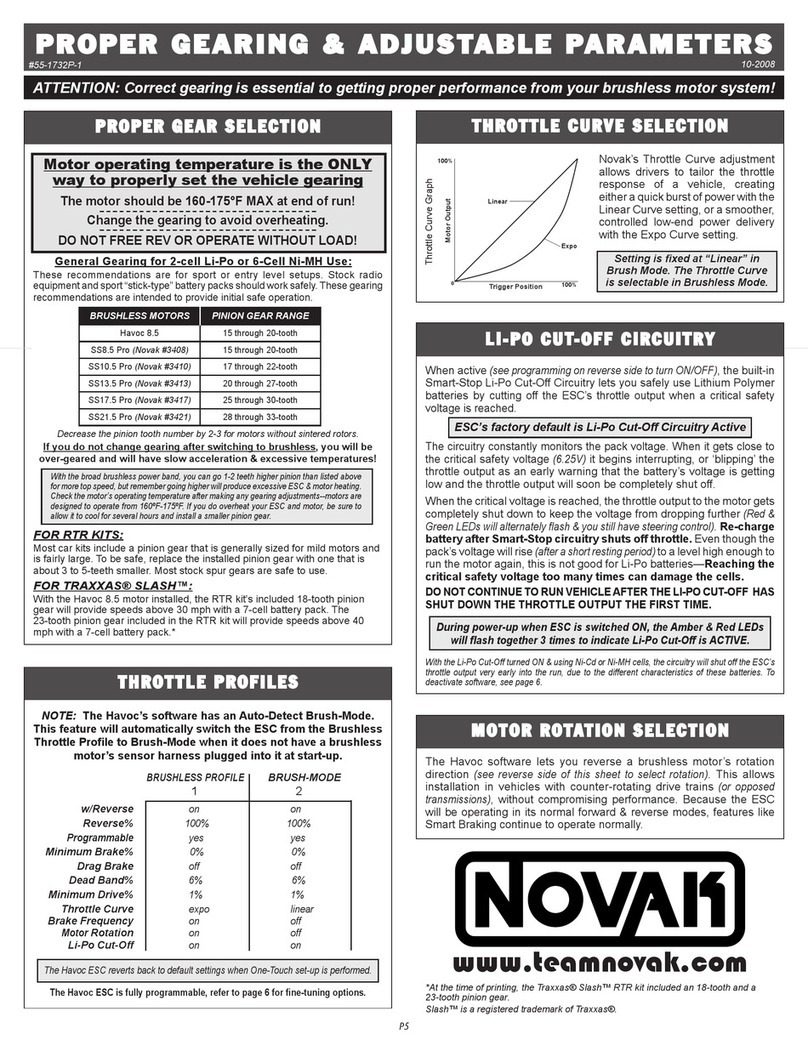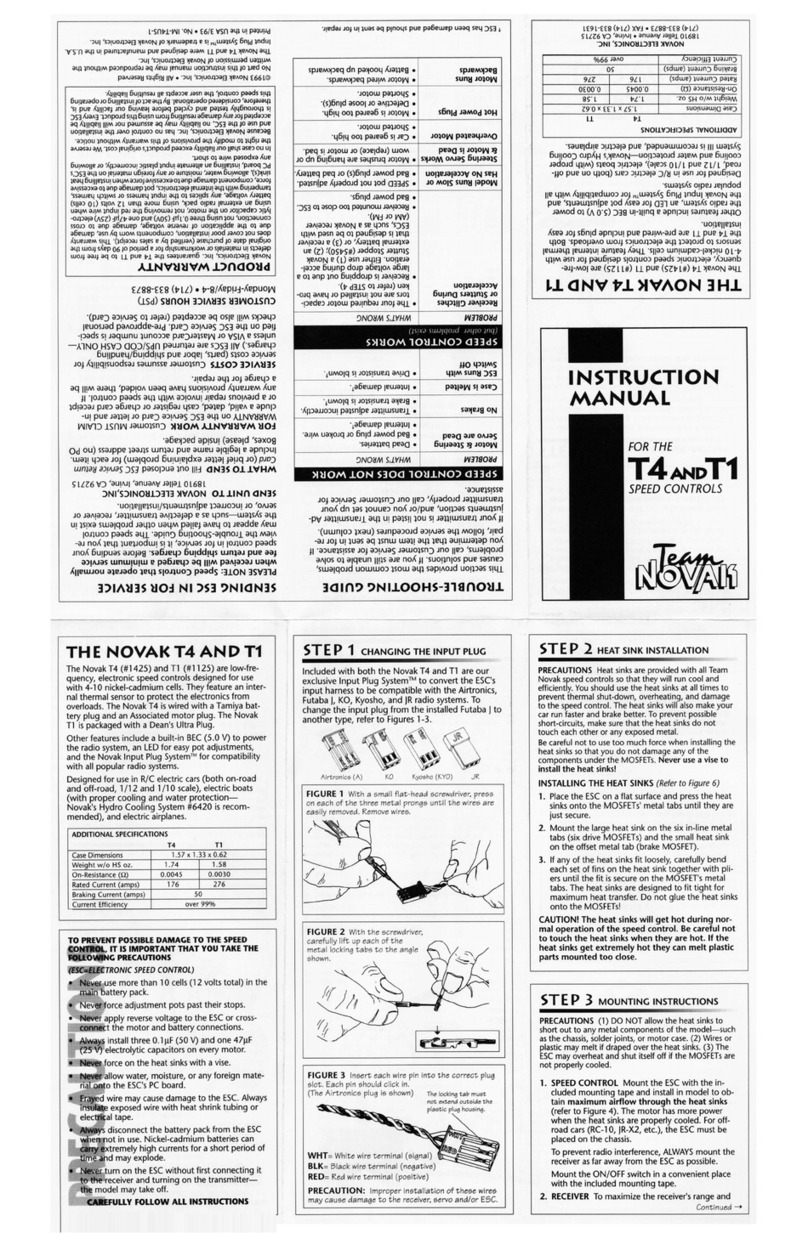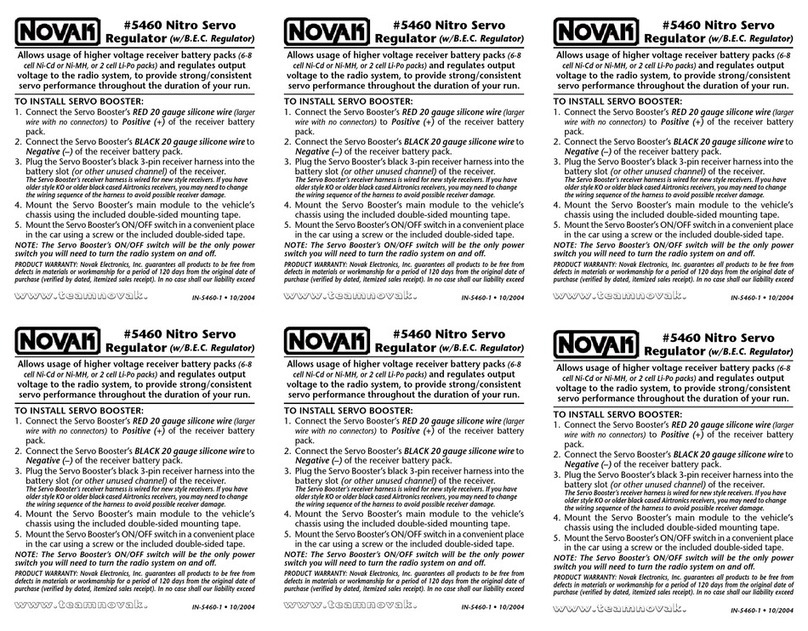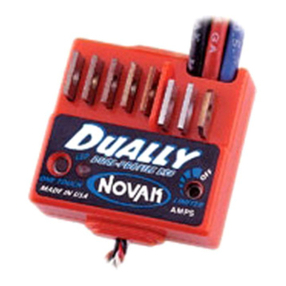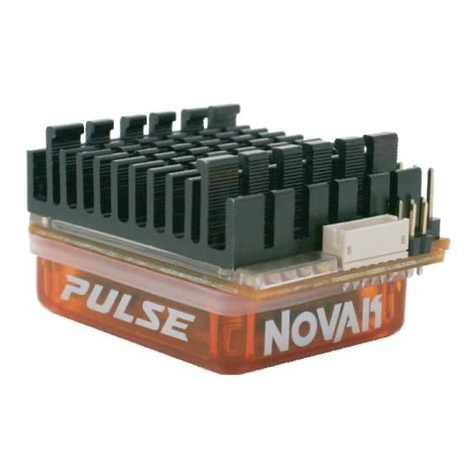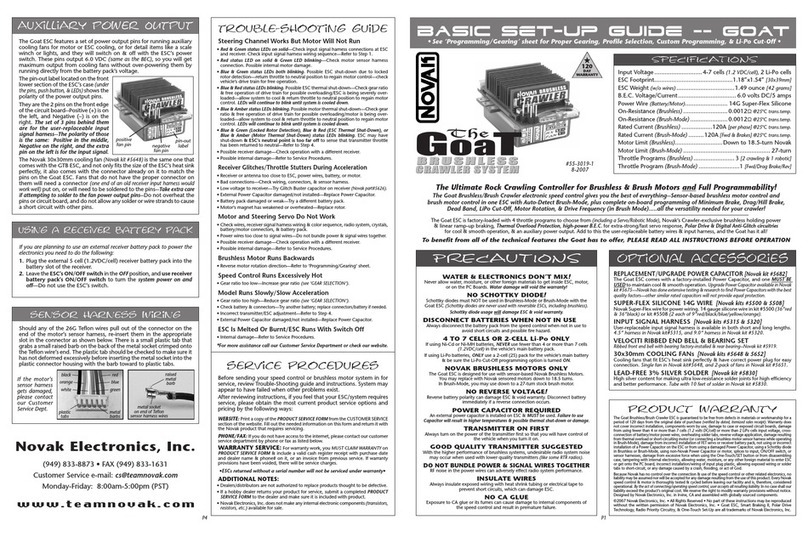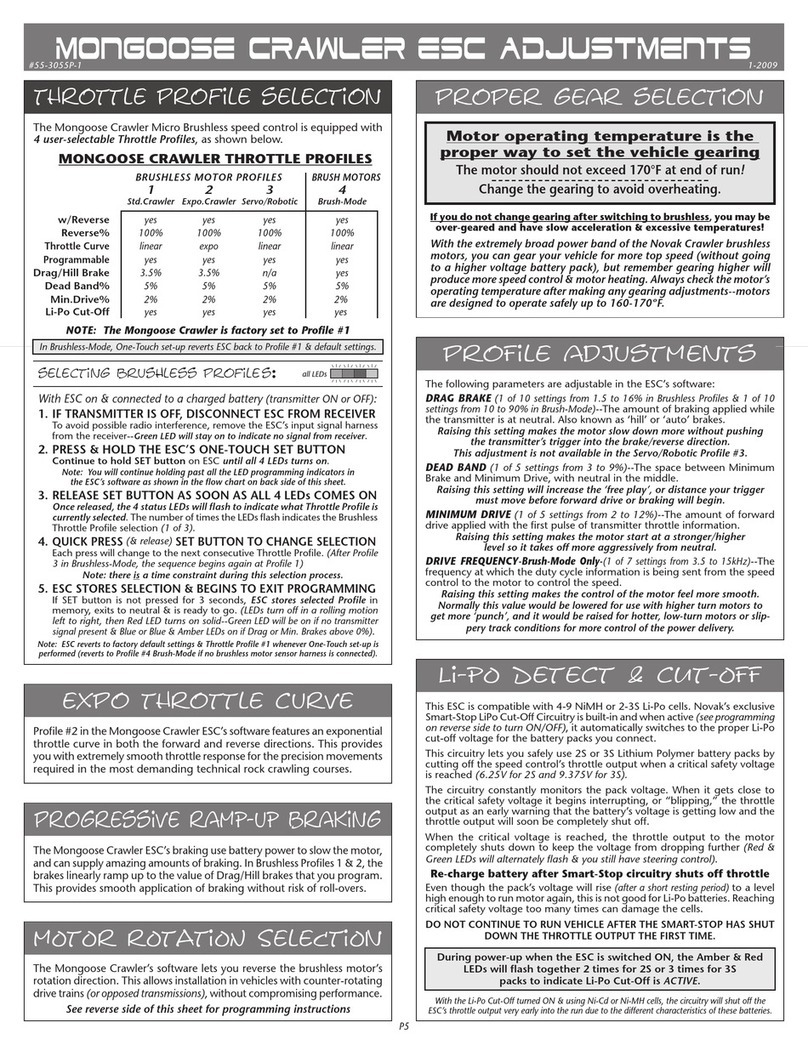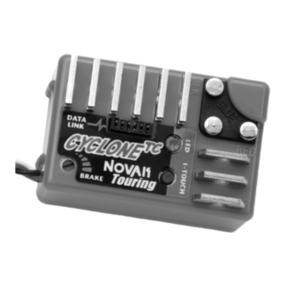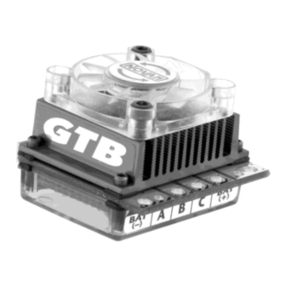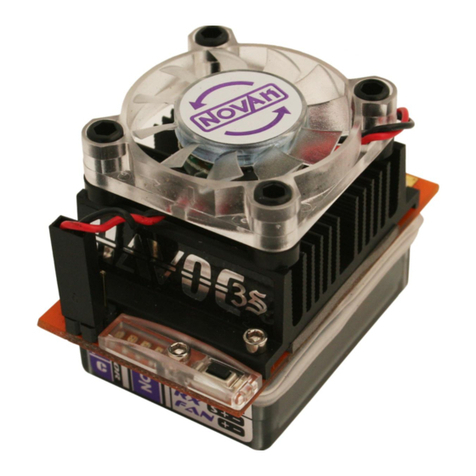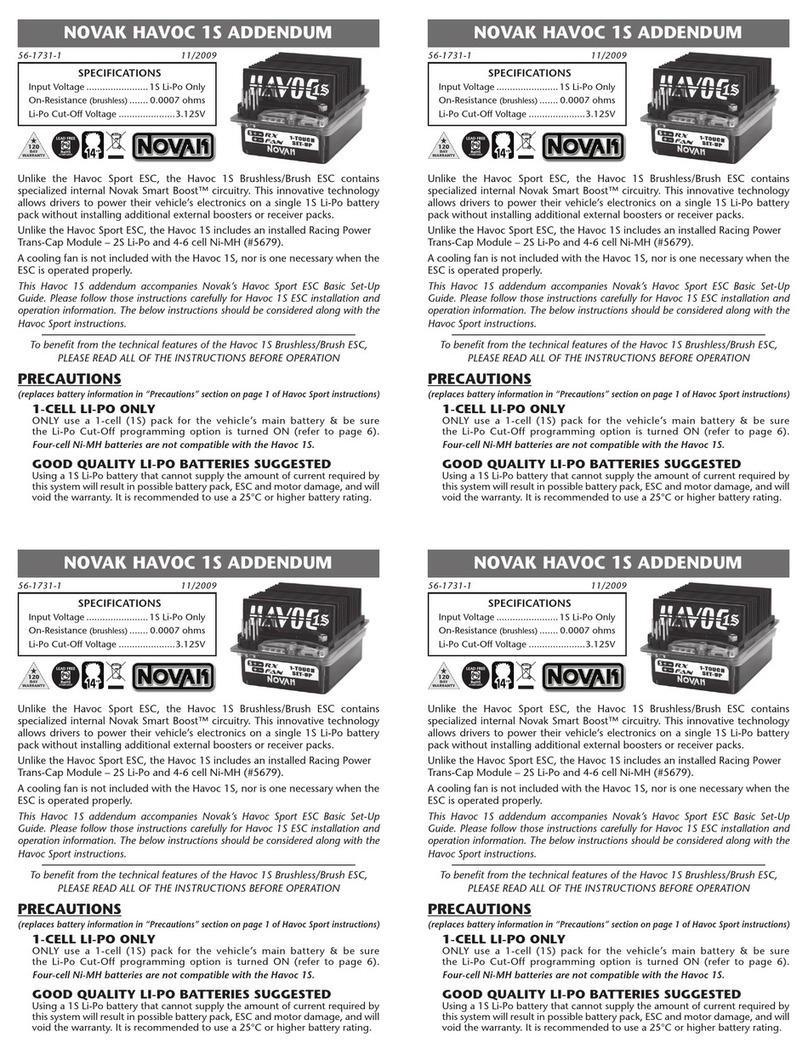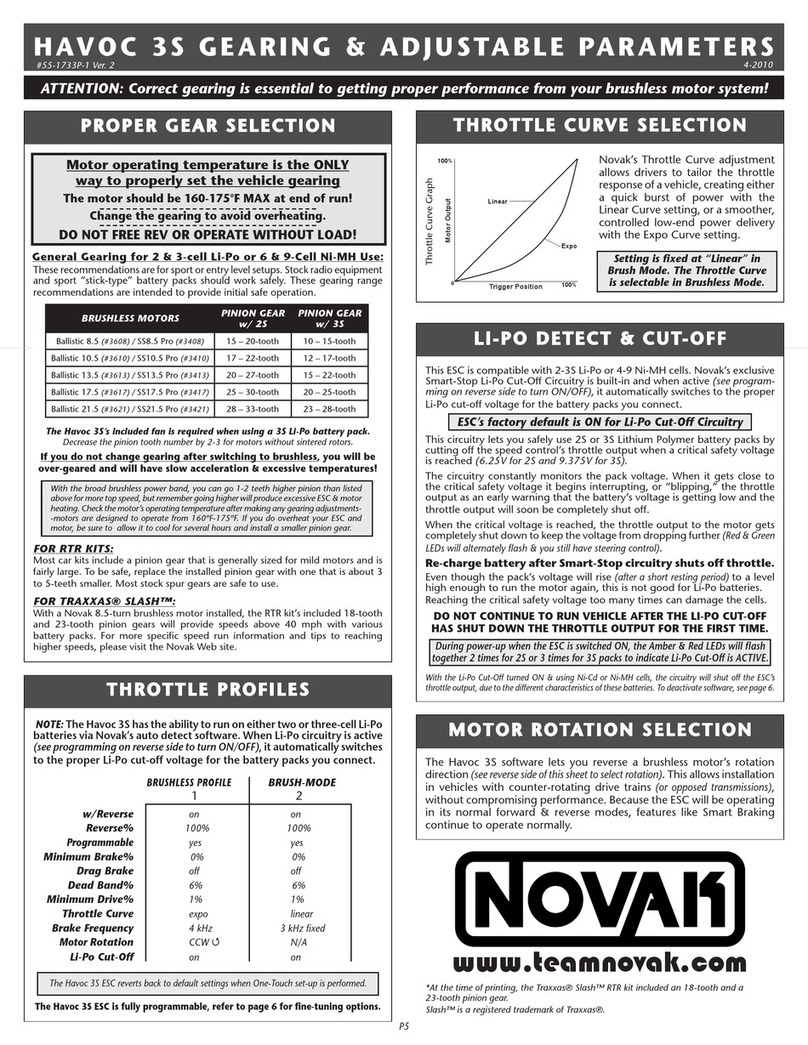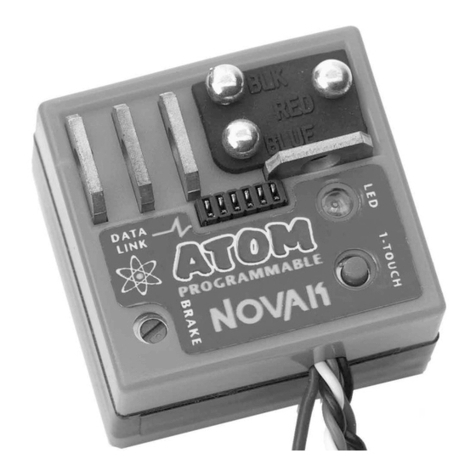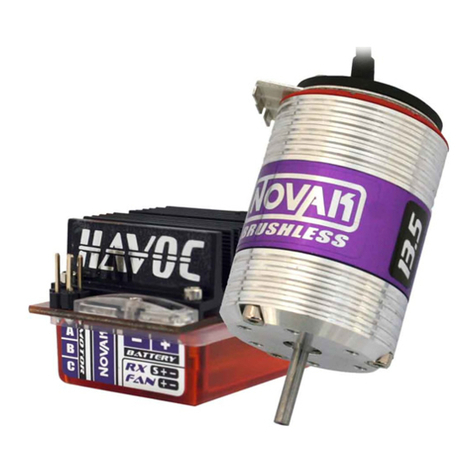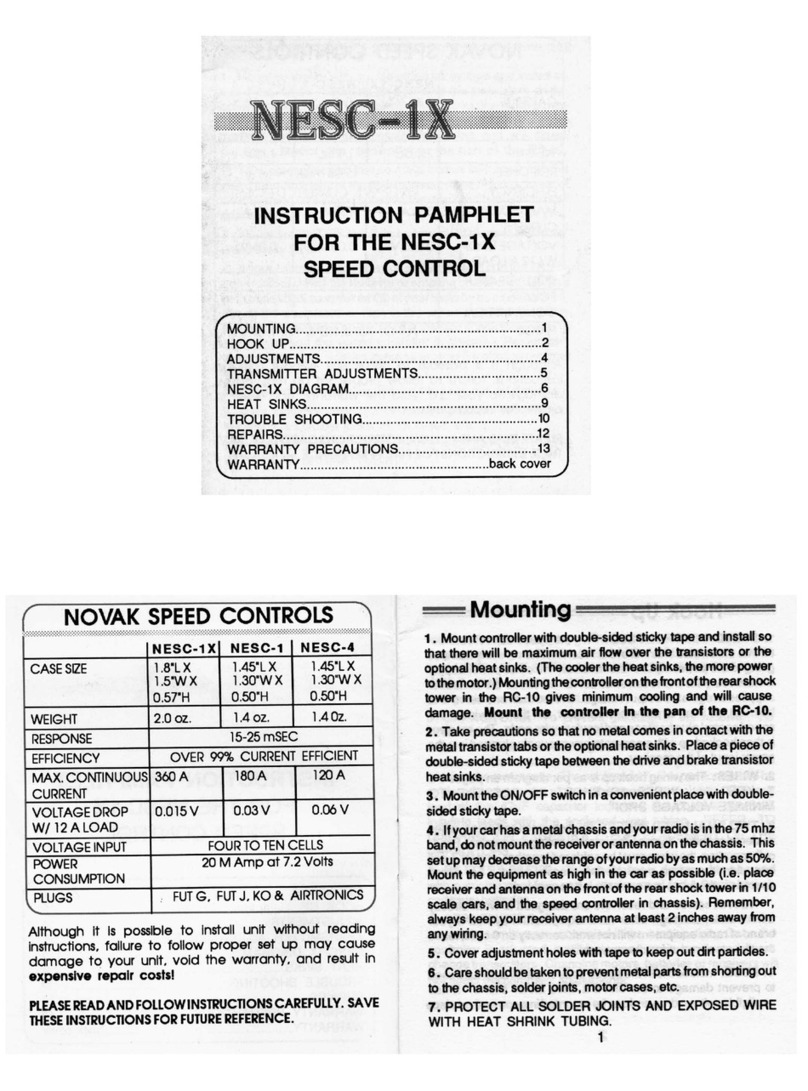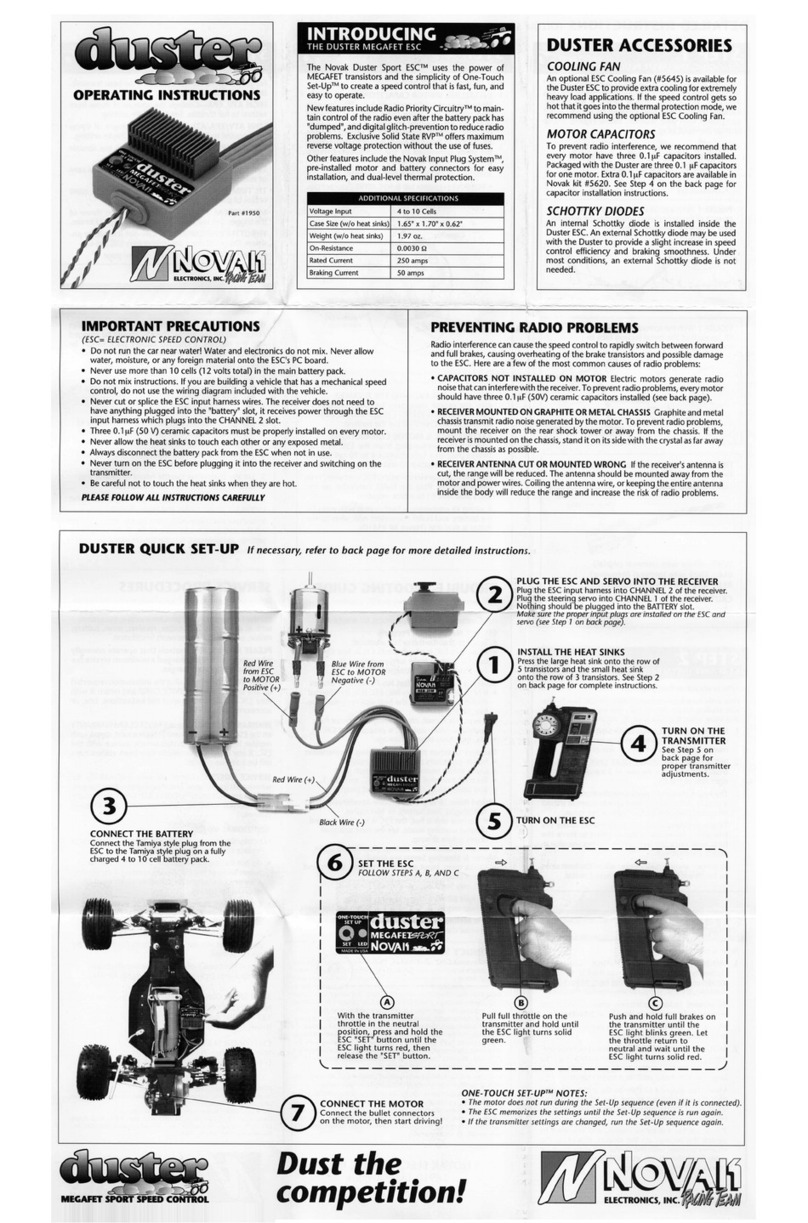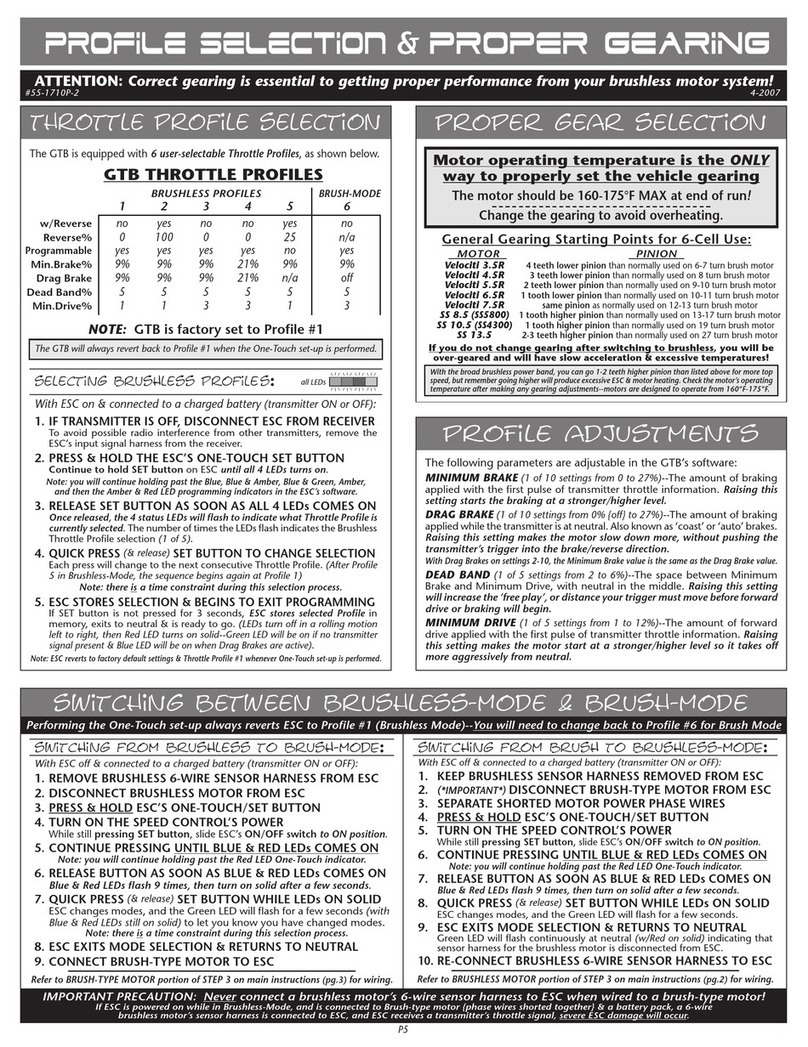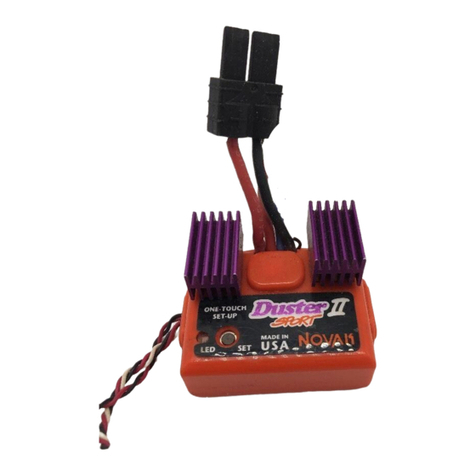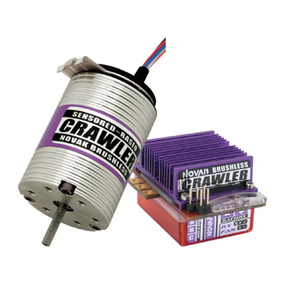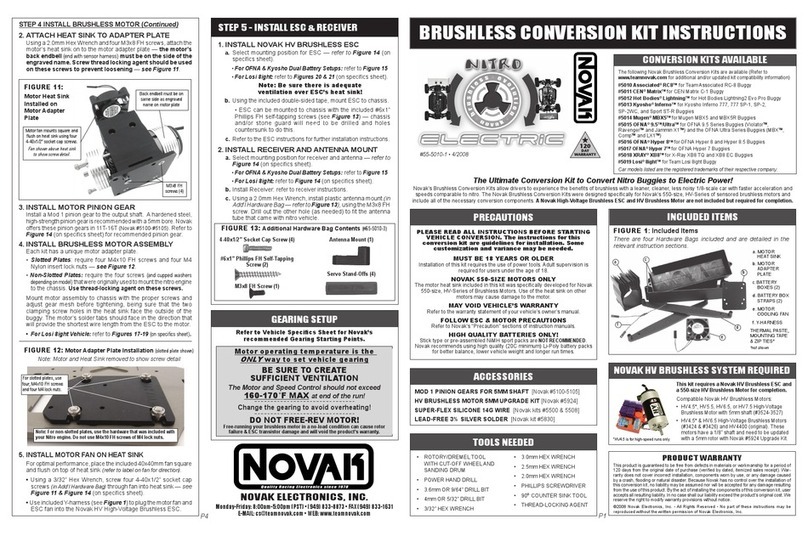Kinetic 1S (#1741)
#55-1740-1 Rev.2
2-2011
SPECIFICATIONS
Input Voltage
–1S ESC
.........................................................1S LiPo
Input Voltage
–2S ESC
..................... 1-2S LiPo/LiFe cells, 4-6 NiMH
ESC Footprint .......................................
1.16”x1.47” (29.5 x 37.3mm)
ESC Weight
–1S
(w/o wires) .......................... 1.15 ounce (32.6 grams)
ESC Weight
–2S
(w/o wires) .......................... 1.29 ounce (36.6 grams)
B.E.C. Voltage/Current (built-in) .................... 6.0 volts DC / 3 amps
Power Wire (Battery/Motor) ......................... 14G Super-Flex Silicone
On-Resistance .................0.00040 ohm per phase
@25°C trans.temp.
PC interface ........................... NovaLink™ Programming Interface
Compatibility ....................................... Sensored Brushless Motors
The Most Advanced Racing Speed Controller
The Kinetic Racing Brushless ESC (#1740) includes Novak’s Dynamic Timing
Advance™ electronic motor timing, NovaBrakes™, Electronic Power Control™
current limiting, on-board temperature monitoring, zero-timing Sportsman
Mode, complete on-board programmability and built-in PC interface.
The Kinetic ESC is loaded with 17 adjustable parameters,
sports a cross-cut heat sink, and includes everything
necessary including a cooling fan & power trans-cap module.
The Kinetic 1S ESC is optimized for 1S racing and features
a low-profile heat sink and 2S LiPo receiver pack harness.
For informative product videos, visit the Team
Novak Channel on YouTube®.
Join Novak’s e-mail list to receive updates about the Kinetic.
To benefit from all of the technical features of the Kinetic,
PLEASE READ ALL INSTRUCTIONS BEFORE OPERATION
NOVALINK™ PROGRAMMING INTERFACE [Novak kit #5440]
Optional fully adjustable PC interface, which includes a USB cord and software disk.
PLUG-IN INPUT SIGNAL HARNESS (MINI-JST) [Novak kits #5304 & #5309]
Includes input signal harness with 2mm mini plug on ESC end for use with Kinetic.
4.5” in Novak kit #5304, and 9” in Novak kit #5309.
BRUSHLESS SENSOR HARNESSES [Novak kit #5351-#5353]
Shielded sensor harness protects sensor wires and provides multiple installation options.
4”/100mm (Novak #5351), 6”/150mm (Novak #5352) & 9”/230mm (Novak #5353).
SUPER-FLEX SILICONE 14GA WIRE SET [Novak kit #5508]
Two each of 9” length black, red, blue, yellow and orange 14GA wire.
SUPER-FLEX SILICONE 12GA WIRE SET [Novak kit #5512]
Two each of 3 ft. length black, red and blue 12GA wire. Optional wire set is perfect for
low-resistance connections.
BRUSHLESS MOTOR CONNECTOR WIRE SET [Novak kit #5332]
Flexible 14GA wire with gold-plated connectors for low-resistance connections.
LOW-PROFILE HEAT SINK [Novak kit #S5431]
For Kinetic/GTB 2/Havoc Pro SC ESCs with 8.5T or higher motor. Includes thermal gap pad.
REMOTE POWER PROGRAMMING SWITCH [Novak kits #5602 & 5604]
Includes ON/OFF Power Switch and Programming Button harness. #5604 for Kinetic 1S.
2-PIN JST HARNESS SET--MALE & FEMALE PIGTAILS [Novak kit #5612]
Includes 1 male & 1 female harness with 22GA silicone wire and 2-pin JST connector on 1 end.
COOLING FANS--25x25x10mm [Novak kits #5649 & #5653]
Cooling fans fit the ESC’s heat sink perfectly & has the Kinetic’s 2mm mini plug for easy
power connection. Single fan in Novak kit #5649, and 2-pack of fans in Novak kit #5653.
POWER TRANS-CAP MODULE [Novak kits #5679 & 5687]
Replacement Power Trans-Cap provides improved efficiency and lowers operating
temperatures. #5679 for 2S LiPo and #5687 for 1S LiPo usage.
POWER CONNECTORS–3.5 & 4mm [Novak kit #5731 & #5741]
Low-Loss connectors generate dozens of wiring routing and installation options.
LEAD-FREE SILVER SOLDER [Novak kit #5831-#5833]
Novak solder contains 3% Silver for high-conductivity and is available in three sizes.
6g in Novak kit #5831, 15g in Novak kit #5832, and 100g in Novak kit #5833.
DOUBLE-SIDED MOUNTING TAPE [Novak kit #5840 & #5841]
Includes cushioned, double-sided tape to secure electronics in vehicles.
10 pieces in Novak kit #5840, and 100 pieces in Novak kit #5841.
HEAT SHRINK TUBING [Novak kit #5850 & #5851]
Novak heat shrink tubing is 6” long and available in six sizes: 1/16” - 3/8”.
6 piece assortment in Novak kit #5850, and 24 piece assortment in Novak kit #5851.
WATER & ELECTRONICS DON’T MIX!
Allowing water, moisture or other foreign materials to get inside ESC will void warranty.
MUST BE 14 YEARS OR OLDER TO OPERATE
This product is not a toy and is not intended for use by children under 14 years of age
without the strict supervision of an adult.
TIMING INCREASES ELECTRONICS’ TEMPERATURES
Use extreme caution when setting up and testing your application to avoid overloading and
overheating the Kinetic ESC and brushless motor. Excessive overheating will void warranty!
SENSOR-BASED BRUSHLESS MOTORS ONLY
The Kinetic ESC is designed for optimal use with Novak sensor-based brushless motors. Motor
may be replaced with sensor-based brushless motors down to 3.5T (540-size) or 4.5T (550-size).
TIMING PRODUCES DANGEROUSLY HIGH SPEEDS
When Novak’s advanced timing is activated, the resulting vehicle speed can be
dangerously high. It is important to take extra precautions.
NO SCHOTTKY DIODES!
Schottky diodes are never to be used with brushless ESCs.
Do not use Schottky diodes with Kinetic ESC!
DO NOT FREE REV OR OPERATE WITHOUT LOAD!
This includes running the motor without a pinion or holding the car in the air and running
the motor at or close to full power. Free revving will void the warranty!
DISCONNECT BATTERIES WHEN NOT IN USE
Always disconnect batteries from ESC to avoid short circuits and possible fire hazard.
1-2S LiPo/LiFe OR 4-6 NiMH CELLS ONLY
If using LiPo or LiFe battery packs, use 1 or 2-cell (1-2S) batteries for the vehicle’s main
battery & be sure the Voltage Cut-Off programming option is turned ON
(refer to Track Guide)
.
If using NiCd or NiMH batteries, NEVER use more than 6 cells (1.2VDC/cell) in the vehicle’s
main battery pack, and disable Voltage Cut-Off Circuitry (refer to Track Guide).
NO REVERSE VOLTAGE!
Reverse battery polarity can damage ESC & void warranty. Disconnect battery immediately
if a reverse connection occurs.
POWER TRANS-CAP MODULE REQUIRED
An external Power Trans-Cap module is installed on ESC & MUST be used at all times.
Failure to use a Novak Trans-Cap module with proper cell rating (1S or 2S, depending on
ESC) will result in higher ESC temperatures & possible thermal shut-down or damage.
TRANSMITTER ON FIRST
Always turn on the power of the transmitter first so that you will have control of the
vehicle when you turn on the electronics.
GOOD QUALITY LiPo/LiFe BATTERIES SUGGESTED
Using batteries that cannot supply the amount of current required by this brushless system
will result in possible battery pack, ESC, and/or motor damage, and will void the warranty.
It is recommended to use cells with a 25C or higher rating.
GOOD QUALITY RADIO SYSTEM SUGGESTED
With the higher performance of brushless systems, undesirable radio system noise may
occur when used with lower quality radio systems. 2.4GHz radio system use is best. An
FM system is acceptable, as long as it is high quality. AM systems are NOT recommended.
DO NOT BUNDLE POWER & SIGNAL WIRES TOGETHER
RF noise in the power wires can adversely effect radio system performance.
INSULATE WIRES
Always insulate exposed wiring with heat shrink tubing or electrical tape to prevent short
circuits, which can damage the ESC.
NO CA GLUE
Exposure to CA glue or its fumes can cause damage to internal components of the ESC
and result in premature failure.
BASIC SET-UP GUIDE – KINEtic
• See “Track Guide” sheet for Proper Gearing, Profile Selection, Custom Programming & One-Touch Set-Up •
PRECAUTIONS
ACCESSORIES
P1P4
product warranty
The Kinetic Racing Brushless ESC (1S or 2S) is guaranteed to be free from defects in materials
or workmanship for a period of 120 days from the original date of purchase (verified by dated,
itemized sales receipt). Warranty does not cover incorrect installation, components worn by
use, damage to case or exposed circuit boards, damage from using more than 6 cells (1.2 volts
DC/cell) or more than 2 LiPo/LiFe cells input voltage, damage due to timing, damage due to
turning off Thermal Overload Protection (via NovaLink™), damage resulting from using LiPo/LiFe
batteries without Smart-Stop circuitry active,
using insufficient LiPo/LiFe batteries that cannot
supply the amount of current required by this system,
cross-connection of battery/motor
power wires, overheating solder tabs, reverse voltage application, improper use or installation of
external BEC, damage resulting from thermal overload or short-circuiting motor, damage from
incorrect installation of FET servo or receiver battery pack,
damage due to free revving motor,
damage due to using a non-Novak motor or a non-sensored motor,
not using or incorrect
installation of a Power Trans-Cap module on the ESC or from using a damaged or incorrect cell-
rating Power Trans-Cap module, using a Schottky diode, splices to input, ON/OFF switch, or
sensor harnesses, damage from excessive force when using the One-Touch/SET button or from
disassembling case, tampering with internal electronics, allowing water, moisture, or any other
foreign material to enter ESC or get onto the PC board, incorrect installation/wiring of input plug
plastic, allowing exposed wiring or solder tabs to short-circuit, or any damage caused by a crash,
flooding, or natural disaster. Melted speed controls or motors are not covered by the warranty.
Because Novak has no control over the connection & use of the speed control or other related
electronics, no liability may be assumed nor will be accepted for any damage resulting from the
use of this product. Every Novak speed control & motor is thoroughly tested & cycled before
leaving our facility and is, therefore, considered operational. By the act of connecting/operating
speed control, user accepts all resulting liability. In no case shall our liability exceed the product’s
original cost. We reserve the right to modify warranty provisions without notice. This product is
not intended for use by children under 14 years of age without the strict supervision of an adult.
Use of this product in an uncontrolled manner may result in physical damage or injuries—take
extra care when operating any remote control vehicle. Designed by Novak Electronics, Inc. in
Irvine, CA and assembled with globally sourced components.
©2011 Novak Electronics, Inc. • All Rights Reserved • No part of these instructions may be
reproduced without the written permission of Novak Electronics, Inc.
Kinetic 2S Racing Brushless ESC, Kinetic 1S Racing Brushless ESC, Dynamic Timing Advance,
Electronic Power Control, NovaBrakes, Smart Braking II, Polar Drive Technology, Radio Priority
Circuitry, & One-Touch Set-Up are all trademarks of Novak Electronics, Inc.
This section shows the polarity of the Kinetic’s output pins. The included receiver
harness (Novak #5309) has a 2mm mini plug on the end that is plugged into the
ESC and a standard JST plug on the receiver end. The included ON/OFF switch on
the Kinetic 2S (Novak #5602) has a standard JST plug on it. Before connecting,
note the wiring sequence of the installed harness connectors as shown here.
The Kinetic 2S’s heat sink is designed to accept a 25x25mm cooling fan, and
comes with nylon 4-40x5/8” screws to secure it. To install, simply center the
fan on the ESC and push the nylon screws down into the cross cuts of the heat
sink. If using metal screws, thread them into the heat sink. Install the fan’s power
connector onto the fan output pins on the ESC--note polarity as shown below.
NOVAK ELECTRONICS, INC.
17032 Armstrong Ave. Irvine, CA 92614
PHONE: (949) 833-8873 • FAX: (949) 833-1631
www.teamnovak.com
service procedures
Before sending your speed control in for service, review the Trouble-Shooting
Guide (in Track Guide). The ESC may appear to have failed when other problems exist.
After reviewing instructions, if you feel that your ESC requires service, please ob-
tain the most current product service options and pricing by the following ways:
WEB SITE: Print a copy of the PRODUCT SERVICE FORM from the CUSTOMER
SERVICE
section of the Web site. Fill out the needed information on this form and
return it with the Novak product that requires servicing.
PHONE/FAX: If you do not have access to the internet, please contact our
customer service department by phone or fax.
WARRANTY SERVICE: For warranty work, you MUST CLAIM WARRANTY
on PRODUCT
SERVICE FORM & include a valid cash register receipt with purchase
date and dealer name & phone # on it, or an invoice from previous service. If
warranty provisions have been voided, there will be service charges.
• ESCs returned without a serial number will not be serviced under warranty •
TRADE-IN PROGRAM: For non-warranty work, Novak offers a trade-in
program for current and discontinued products. You can replace, exchange or
upgrade any Novak speed control to any available speed control listed within the
trade-in program. You must complete a Non-Warranty Service Form to be eligible.
ADDITIONAL NOTES:
•
Dealers/distributors aren’t authorized to replace products thought to be defective.
• If a hobby dealer returns your product for service, submit a completed PRODUCT
SERVICE FORM to the dealer and make sure it is included with product.
• Novak Electronics, Inc. does not make any internal electronic components
(transistors, resistors, etc.) available for sale.
CONTACT:
When active (see Track Guide to turn ON/OFF), the built-in Novak Smart-Stop
Voltage Cut-Off Circuitry lets you safely use 1S or 2S Lithium Polymer (LiPo) or
Lithium Iron Phosphate (LiFe) battery packs by cutting off the speed control’s
throttle output when the critical safety voltages are reached.
The circuitry constantly monitors the pack voltage and automatically selects a 1S
or 2S cut-off voltage
[3.125V (1S), 6.25V (2S) Li-Po; 2.375V (1S), 4.75V (2S) Li-Fe]
.
When the ESC detects that the critical safety voltage will soon be reached, it begins
interrupting, or “blipping,” the throttle output as an early warning that the battery’s
voltage is getting low and the throttle output will soon be completely shut off.
When the critical voltage is reached, the throttle output to the motor gets
completely shut down to keep the voltage from dropping further (Red & Green
LEDs will alternately flash & you still have steering control).
Re-charge battery after Smart-Stop circuitry shuts off throttle
Even though the pack’s voltage will rise
(after a short resting period)
to a level high
enough to run motor again, this is not good for LiPo or LiFe batteries.
Reaching critical safety voltage too many times can damage the cells.
DO NOT CONTINUE TO RUN VEHICLE AFTER THE SMART-STOP HAS SHUT
DOWN THE THROTTLE OUTPUT THE FIRST TIME.
When the ESC is switched ON, the Yellow & Red LEDs will flash
together 3 times to indicate LiPo/LiFe Cut-Off is ACTIVE.
With the Voltage Cut-Off Circuitry turned ON & using NiCd or NiMH cells, the circuitry will
shut off the ESC’s throttle output very early into the run, due to the different characteristics of
these batteries. Change the ESC’s Voltage Cut-Off Circuitry mode to OFF to use these batteries.
See CUSTOM PROGRAMMING options on the Track Guide to properly adjust this setting.
With the ESC connected to (at least) a charged battery pack, the receiver, and the
brushless motor’s sensor harness:
1. TURN ON THE TRANSMITTER’S POWER
2. PRESS & HOLD ESC’S ONE-TOUCH/SET BUTTON
3. TURN ON THE SPEED CONTROL’S POWER
With transmitter throttle at neutral, and still pressing the
SET button, slide the ESC’s
ON/OFF switch to ON position.
4.
CONTINUE HOLDING SET BUTTON UNTIL RED LED COMES ON
5. RELEASE SET BUTTON AS SOON AS LED TURNS RED
6.
PULL TRANSMITTER THROTTLE TO FULL-ON POSITION
Hold it there until the green status LED turns solid green.
Note: Motor will not run during programming even if connected.
7. PUSH TRANSMITTER THROTTLE TO FULL-BRAKE/REVERSE
Hold it there until the green status LED blinks green.
8. RETURN TRANSMITTER THROTTLE TO NEUTRAL
The red status LED will turn solid red, indicating that speed control is at neutral
and that proper programming has been completed.
Blue & yellow LEDs will also be
on indicating Minimum Brake (blue) & Drag Brake (yellow) settings are at levels above 0%.
If transmitter settings are changed, the One-Touch Programming must be repeated.
If you experience any problems, turn off ESC and repeat One-Touch.
NOTE: Whenever the One-Touch Programming set-up is performed, the
speed control will automatically revert back to the factory-default settings.
If you are planning to use an external receiver battery pack with the Kinetic 2S ESC
to power the electronics you need to do the following:
1. Plug the external 5 cell (1.2VDC/cell) receiver battery pack into the battery
slot of the receiver.
2. To turn the vehicle ON, switch the receiver pack ON. Then, turn the ESC’s
switch ON, then OFF to allow the ESC to be powered by an external source.
3. To turn the vehicle OFF, turn the receiver pack’s switch OFF.
ALTERNATIVE METHOD
1. Plug the external 5 cell (1.2 VDC/Cell) receiver battery pack into the battery
slot of the receiver.
2. Unplug the ESC’s red wire from the input harness going to the receiver. Insulate
the red wire to keep it from shorting.
3. To turn the vehicle ON, switch the receiver pack ON, then turn the ESC’s switch ON.
4.
To turn vehicle OFF, turn ESC’s switch OFF, then turn receiver pack’s switch OFF.
OPTIONAL RECEIVER PACK USAGE
STEP 6-one-touch programming
VOLTAGE cUt-OFF circuitry
Wiring and cooling fan
standard
JST plug
2mm
Mini plug
Sensor harness
FIGURE 5
Receiver harness
ON/OFF
switch
black wire
(negative)
red wire
(positive)
white wire
(signal)
Fan power
output pins
black wire
(negative)
positive
fan pin
negative
fan pin
Novak
#5649
installed
FIGURE 4
www.teamnovak.com

